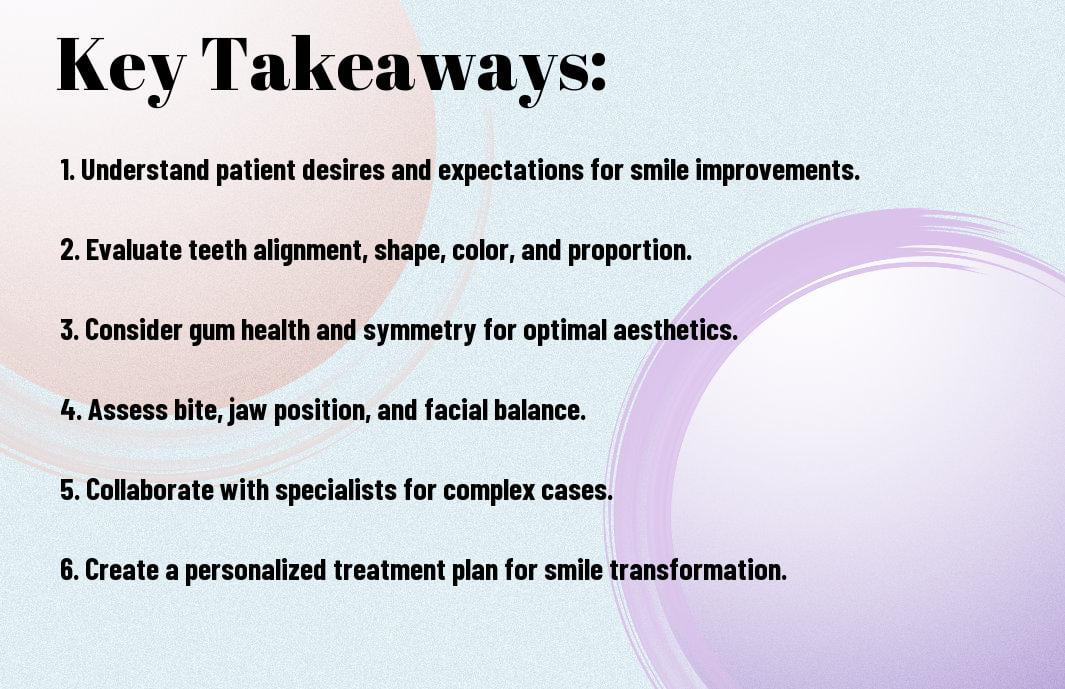Smile brightens your face and speaks volumes about you. As far as planning treatments for your smile, several crucial factors are carefully examined to ensure the best outcome. From dental health to aesthetic preferences, each element plays a significant role in crafting a personalized treatment plan that suits your unique needs. In this informative blog post, discover the necessary factors considered in a comprehensive smile assessment and how they influence the treatment planning process.
Key Takeaways:
- Facial Symmetry: When planning treatments for a smile assessment, considering facial symmetry is crucial as it contributes significantly to overall aesthetics.
- Tooth Color and Shape: The color and shape of each tooth play a vital role in treatment planning, as they directly impact the overall appearance of the smile.
- Gum Health: Evaluating gum health is vital in treatment planning as healthy gums are the foundation for a beautiful smile and optimal oral health.
The Importance of Smile Assessment
A comprehensive smile assessment is crucial in determining the best treatment plan for you. Your smile is one of the first things people notice about you, and it can greatly impact your confidence and self-esteem. By taking a detailed look at various factors that contribute to your smile, such as tooth alignment, shape, color, and gum health, a dentist can create a tailored plan to enhance your smile and overall oral health.
Why a Comprehensive Approach Matters
An approach that considers all aspects of your smile is necessary for achieving optimal results. Simply focusing on one aspect, such as teeth alignment, without taking into account other factors like gum health or tooth color, may lead to subpar outcomes. A comprehensive approach ensures that all elements of your smile are harmoniously addressed, resulting in a beautiful and natural-looking smile that suits your unique facial features.
Consequences of Inadequate Assessment
Assessment that is superficial or limited in scope can result in unsatisfactory treatment outcomes. Inadequate evaluation may overlook underlying issues that could affect the success of the treatment plan. For example, failing to address gum health issues before cosmetic procedures can lead to complications and compromised results. Therefore, a thorough smile assessment is crucial to identify and address all pertinent factors to achieve the best possible results.
Patient History and Expectations
Gathering Relevant Medical and Dental History
To begin a comprehensive smile assessment, it is vital to gather detailed medical and dental history from the patient. Any underlying medical conditions, medications being taken, past surgeries, allergies, and any dental treatments received in the past are crucial pieces of information that can impact the treatment plan. It is important to understand your overall health and how it may relate to your dental care.
Identifying Patient Goals and Concerns
One of the most critical aspects of a comprehensive smile assessment is understanding your goals and concerns. Patient input is invaluable in creating a treatment plan that aligns with your expectations. You may have specific aesthetic preferences, such as a desire for whiter teeth or a straighter smile, or you may be concerned about issues like tooth sensitivity or gum health. Communicating these goals and concerns will help your dental provider tailor a treatment plan that meets your needs.
It is crucial to remember that your smile is unique to you, and what you envision as an ideal smile may be different from someone else’s. By voicing your goals and concerns, you empower your dental provider to create a treatment plan that not only addresses any dental issues but also helps you achieve the smile you desire.
Clinical Examination
Many factors are considered during a comprehensive smile assessment, starting with a detailed clinical examination.
Visual Examination of the Teeth and Surrounding Tissues
With a visual examination, your dentist will assess the condition of your teeth, gums, lips, and surrounding oral tissues. They will look for signs of decay, gum disease, malocclusions, and other issues that may affect your smile. This examination helps in identifying any visible abnormalities that need to be addressed in the treatment plan.
Radiographic Analysis (X-Rays, CT Scans, etc.)
Examination of radiographs such as X-rays and CT scans provides a more in-depth view of your oral structures, including the roots of your teeth, jawbone, and alignment of your bite. These images help the dentist evaluate the health of your teeth below the gum line, identify any hidden issues, and plan appropriate treatments for optimal results.
Surrounding your smile assessment, the radiographic analysis plays a crucial role in capturing a comprehensive view of your oral health, allowing for a thorough evaluation and precise treatment planning.
Facial Aesthetics and Smile Analysis
Evaluating Facial Symmetry and Proportions
Not all smiles are created equal; each one is unique, just like you. When evaluating your facial symmetry and proportions, your dentist or orthodontist will carefully assess the alignment of your facial features, such as your eyes, nose, and lips. These elements play a crucial role in determining the overall harmony of your smile.
Assessing Smile Width, Shape, and Tooth Display
With a keen eye for detail, your dental professional will analyze your smile width, shape, and tooth display. The width of your smile should be in proportion to the rest of your facial features, ensuring a natural and aesthetic appearance. Additionally, the shape of your smile and the amount of tooth display when you grin are vital considerations in creating a harmonious and attractive smile.
Analysis of your smile width, shape, and tooth display is vital in treatment planning. By carefully evaluating these factors, your dental provider can tailor a treatment plan that addresses any discrepancies and enhances the overall aesthetics of your smile. Whether through orthodontic treatment, cosmetic procedures, or a combination of both, optimizing these elements will result in a smile that not only looks beautiful but also complements your unique facial features.
Occlusion and Bite Analysis
Unlike other aspects of a smile assessment, occlusion and bite analysis focus on the alignment and function of your teeth when you bite down. Evaluating your occlusion is crucial in determining how your upper and lower teeth fit together and if there are any issues with your bite.
Evaluating the Relationship Between Upper and Lower Teeth
Bite alignment is necessary in ensuring that your teeth come together correctly when you close your mouth. Your dentist will assess how your upper and lower teeth meet and whether there are any discrepancies that need to be corrected. Issues such as overbites, underbites, crossbites, and open bites can impact your dental health and overall smile aesthetics.
Identifying Issues with Bite Force and Distribution
Any imbalances in your bite force and distribution can lead to problems such as teeth grinding, jaw pain, and uneven wear on your teeth. Your dentist will evaluate how your bite force is distributed across your teeth and identify any areas of excessive pressure or strain. Addressing these issues can help prevent future dental problems and improve the longevity of your smile.
Soft Tissue Analysis
Once again, in the process of a comprehensive smile assessment, the evaluation of soft tissues plays a crucial role in determining the overall aesthetics of your smile. This assessment involves analyzing the health and appearance of your gums and lips.
Examining the Health and Appearance of Gums and Lips
Appearance-wise, the health and color of your gums are imperative factors. Healthy pink gums that form a harmonious frame around your teeth contribute significantly to a beautiful smile. Additionally, the symmetry of your lips and the extent of gum display when you smile are also key aspects to consider in soft tissue analysis. Dentists pay close attention to any signs of inflammation, recession, or irregularities in the gum tissue that might affect the overall aesthetics of your smile.
Assessing the Impact of Soft Tissue on Smile Aesthetics
Soft tissue plays a vital role in smile aesthetics as it complements the teeth and supports facial harmony. The position and shape of your gum tissue can influence the perceived length of your teeth and affect the balance of your smile. Additionally, the contour of your lips and the amount of gum show during smiling are crucial factors in determining the overall attractiveness of your smile.
With this in mind, your dentist will carefully assess the soft tissue dynamics of your smile to create a treatment plan that addresses any concerns and helps you achieve a balanced and aesthetically pleasing smile.
Conclusion
So, understanding the factors that are considered in comprehensive smile assessment for treatment planning is crucial for achieving the best possible outcomes for your dental health. By taking into account various aspects such as tooth alignment, gum health, facial features, and overall harmony, your dentist can create a customized treatment plan to address your specific needs and goals.
Note, your smile is a key aspect of your overall appearance and confidence. By working closely with your dental care provider and discussing your concerns and desires, you can ensure that your treatment plan is tailored to help you achieve a smile that you can be proud of. Trust in the expertise of your dentist and embrace the process of comprehensive smile assessment to unlock the full potential of your smile.
FAQ
Q: What is a Comprehensive Smile Assessment?
A: A Comprehensive Smile Assessment is a detailed evaluation conducted by a dental professional to assess various factors that contribute to a patient’s smile, such as teeth alignment, color, shape, and overall oral health.
Q: What factors are considered in Treatment Planning during a Comprehensive Smile Assessment?
A: During a Comprehensive Smile Assessment, factors such as dental health history, facial symmetry, gum health, bite alignment, and patient preferences are carefully evaluated to create a personalized treatment plan.
Q: Why is a Comprehensive Smile Assessment important for Treatment Planning?
A: A Comprehensive Smile Assessment is crucial for Treatment Planning as it helps dental professionals understand the unique needs and goals of each patient, allowing them to recommend the most suitable treatments for achieving a healthy and beautiful smile.







